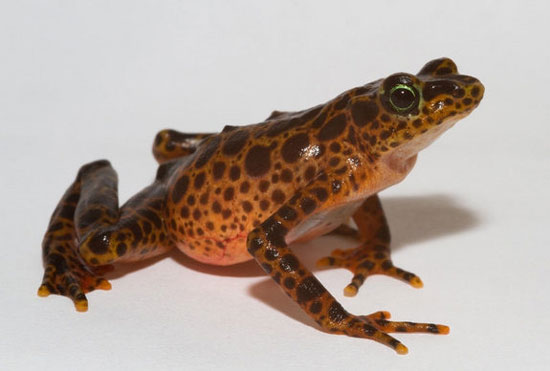Save the frog from the risk of global wiping
Scientists say there are a number of methods to cure frog fungus, which pushes this amphibian into a global risk of being eradicated.
One of the techniques for treating fungal skin diseases for frogs has been successful in the laboratory, which is the technique of capturing tadpoles at high temperatures . The infected tadpoles were kept at 69.8 degrees F (21 degrees C), hotter than their habitats in natural conditions until they became adult frogs. They will then be released into the natural environment.

Atelopus certus frog, one of the amphibians is badly affected by fungal diseases (Source Livescience)
Another similar treatment is to bathe frogs in duitraconazole antifungal solution for eight consecutive days. The solution has the effect of slowing the growth of fungi causing infections; Since 2009, the number of infected frogs has increased significantly.
However, researchers are hesitant to widely apply new treatments because of the possibility of re-infection can occur with both methods.
In just 30 years, the fungal disease called Batrachochytrium dendrobatidis has spread at a rapid rate causing the decline or extinction of about 200 species of amphibians, according to the US Fish and Wildlife Service. . The disease kills frogs by severely disrupting skin functions.
Currently a group of international researchers are studying different techniques to prevent the spread of the disease and the potential extinction of frogs.
Currently the only effective way to protect this species is to establish places to confine large endangered frogs.
- Detecting new frogs 'tiny', excessively placed on nails
- Bunch of toxic, strange and rare amphibians in the world
- Outstanding sprawling colors of tree frogs
- Discovered the new 'tiny' frog species Diasporus in Costa Rica
- Students create 'killer frogs' in the laboratory
- Discovered new tree frog species in the Central Highlands
- Study frog's saliva to create new glue
- Black Rain Frog - Frog has a horrifying body and face
- Video: Green frog swallowed solid for two minutes
- Image: Frogs exercise
- Marvel at giant frogs, 1m long, 8kg heavy
- Frog species heard by mouth
 Animal 'suffering' after hibernation
Animal 'suffering' after hibernation Why do goats climb well?
Why do goats climb well? Scientists were surprised to see chimpanzees eating turtles
Scientists were surprised to see chimpanzees eating turtles Giant catfish died deadly due to drought in Thailand
Giant catfish died deadly due to drought in Thailand